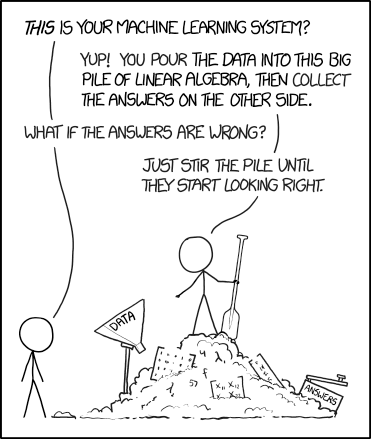Welcome to the graduate course on machine learning at the Albert Einstein Center for Fundamental Physics of the University of Bern!

Figure reference: https://xkcd.com/1838/
Machine learning is a subfield of artificial intelligence that focuses on using algorithms to parse data, learn from it, and then make predictions about something in the world. In the last decade, this framework has led to significant advances in computer vision, natural language processing, and reinforcement learning. More recently, machine learning has begun to attract interest in the physical sciences and is rapidly becoming an important part of the physicist's toolkit, especially in data-rich fields like high-energy particle physics and cosmology.
Timetable: 14:15 to 16:00 on Tuesdays via Zoom due to the COVID-19 pandemic.
Class Slack group: ml-for-physics.slack.com
If you need to contact me, I strongly encourage you to do so via Slack since I'll check this a few times per day.
This course provides students with a hands-on introduction to the methods of machine learning, with an emphasis on applying these methods to solve physics problems. By the end of this course, it is expected that students will:
- Know how to approach physics problems from a machine learning perspective;
- Understand the fundamental principles behind extracting useful knowledge from data;
- Understand the core concepts and terminology of machine learning;
- Gain hands-on experience with mining data for insights.
Throughout the course, students will also have the opportunity to learn several technical skills:
- Python programming and experience with the core libaries for data analysis, visualisation, and modelling.
- Working with data: collecting, cleaning, and transforming.
- Creating and interpreting descriptive statistics.
- Creating and interpreting data visualisations.
- Practical experience with machine learning.
Due to constraints placed by the COVID-19 pandemic, the course will be delivered entirely via online lectures. Each lecture will involve a mix of theoretical and programming work, with an emphasis on the latter. A tentative outline for the course is shown in the table below.
We will be teaching the class entirely via Jupyter notebooks in Python. You can open and run them directly on Binder or Google Colab by clicking on the badges
at the top of each lecture notebook. We highly encourage the use of Binder or Colab, since they require no local installation and run for free.
A few remarks about Binder:
- Binder is free to use.
- If you edit a notebook make sure you download it, since Binder does not save your changes.
- Binder will automatically shut down user sessions that have more than 10 minutes of inactivity (if you leave your browser window open, this will be counted as “activity”).
- Binder aims to provide at least 12 hours of session time per user session. Beyond that, it is not guaranteed that the session will remain running.
Since Binder does not save your changes permanently, you should download the notebooks you worked on at the end of your session. If you want to continue your session later on you can re-upload them to Binder. See the image below for instructions how to upload and download files.
You can also run the course material locally on your laptop. In general, when working with Python it is recommended to use virtual environments. This makes sure that the packages you install don't interfere with the packages you already installed in other projects.
To install the library associated with the course run the following command:
pip install hepmlTo install JupyterLab (a more advanced environment than Jupyter notebooks) run:
pip install jupyterlabThen make sure you download all course material from the GitHub repository or just the missing notebooks. In general you will need to copy all materials, since some resources such as images are not self-contained in the notebooks.
Finally, to start JuypterLab run:
jupyter-labSince we are developing the materials throughout the course you will need to update your local environment every time we move on to the next lesson. To do so just run the following command before you start JupyterLab
pip install --upgrade hepmlMachine Learning
- J. Howard, Introduction to Machine Learning for Coders,
- P. Mehta et al., A high-bias, low-variance introduction to Machine Learning for physicists
- A. Géron, Hands-On Machine Learning with Scikit-Learn and TensorFlow,
- J. Murugan and D. Robertson, An Introduction to Topological Data Analysis for Physicists: From LGM to FRBs
The structure of the lectures is adapted (with permission) from Jeremy Howard's excellent machine learning course for coders, while the theoretical content is based on the comprehensive review articles by Mehta et al and Murugan and Roberston.
Python Programming
- W. McKinney, Python for Data Analysis,
We will use the Python programming language to analyse and visualise a variety of datasets in this course. McKinney’s book is an excellent reference to have at hand and covers the nuts and bolts of the NumPy and pandas packages.
Kaggle Learn
Kaggle Learn is a great resource to brush up on concepts like Python basics, data visualisation or pandas in an online notebook environment (similar to Binder).
